Imagine being the mother-in-law who inspired the snake plant’s other common nickname, “mother-in-law’s tongue!” What an interesting relationship that must’ve been.
Nicknames aside, these species are often considered staples among those who enjoy having potted plants inside their homes and are one of the first plants that new indoor gardeners shopping for specimens inevitably discover.

We link to vendors to help you find relevant products. If you buy from one of our links, we may earn a commission.
Both novice and seasoned houseplant enthusiasts may be surprised to learn that there are many options among these to include in their collection.
Along with the widely available types with long, narrow leaves, there are cylindrical, dwarf, and even corkscrew versions that not only add a bit of greenery to the interior landscape, but serve as eye-catching focal points.
We’ll cover the most distinctive types that make excellent choices for the indoor garden. Be prepared for some follow-up shopping since you’ll undoubtedly want to bring some of these home!
Here’s a sneak peek at all of the varieties in our roundup:
Snake plant species and cultivars can be grown indoors anywhere in the world. That’s good news if your region doesn’t provide suitable conditions, such as warm temperatures for most of the year.
Note that all snake plants require the type of climate found in USDA Hardiness Zones 9 to 11 for year-round, outdoor growing. Outside of those regions, indoor growing is best.
These plants can also be moved outdoors in temperatures above about 60ﹾF and brought back in when the chill returns.
A quick word of caution, however – all snake plants are mildly toxic to both humans and pets, and not just the berries that are produced after blooming. Keep them away from any creature that might venture a nibble to avoid harm.
For comprehensive information on caring for snake plants, see our growing guide.
Now, let’s take a look at some of the best, most unique, and most visually alluring varieties to grow as houseplants.
This roundup includes a carefully curated list of distinctive, easy-care types for indoor growing.
You’ll find a range of choices here that illustrate some of the coolest variations among the former members of the Sansevieria genus.
1. African Bowstring
Although Dracaena hyacinthoides (syn. Sansevieria hyacinthoides), otherwise known as African bowstring hemp, is considered invasive in the wild, it makes an attractive houseplant!
This species got its common name from the long, tough fibers that run through its leaves, which were commonly gathered for use as bowstrings.
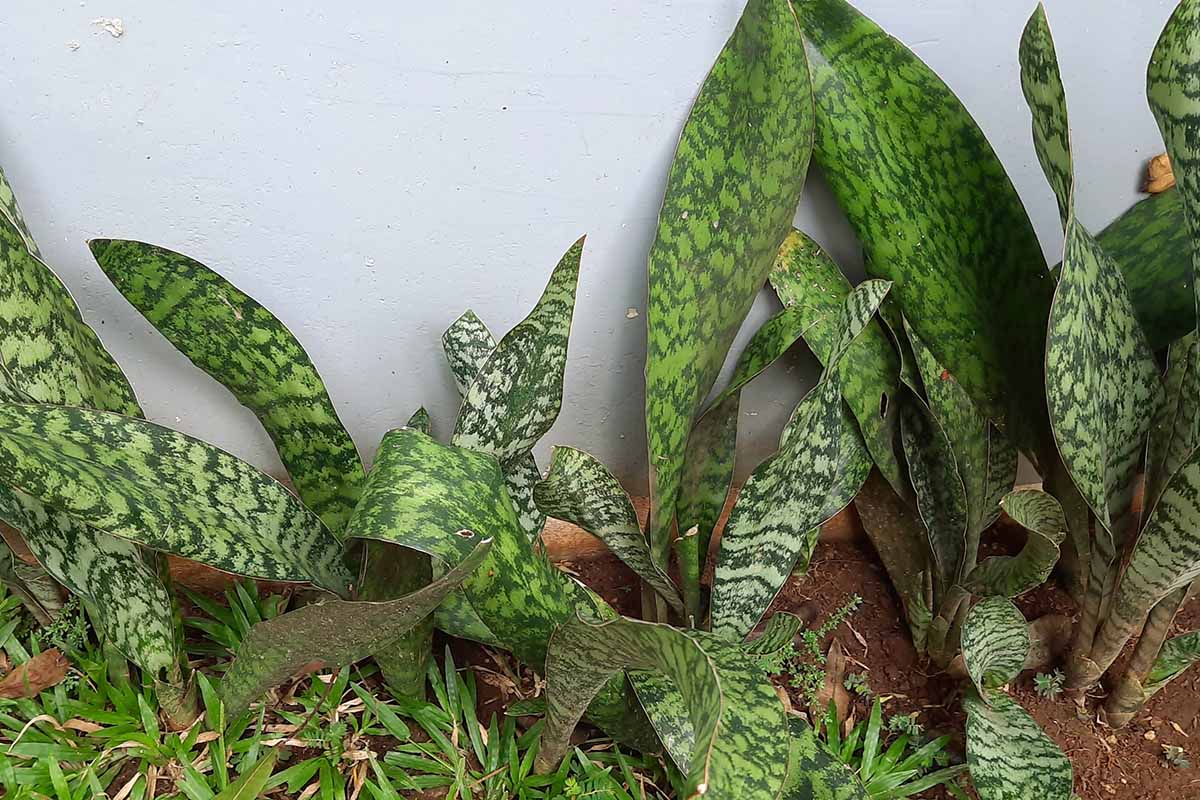
This is a mid-sized species that reaches about 10 to 12 inches in height at maturity, with leaves that sprout from a central stem at the base.
The plants have a narrow silhouette overall, but also spread through offshoots that sprout from their rhizomes, so they can easily fill out a wider planter over time.
Wide, mottled, light and dark green leaves are narrow at the base and the tip and widen in the center, and their rare racemes sport white to pale green buds and wispy blooms, which makes for quite a lovely presentation.
2. Banana
Sometimes known as ‘Samurai,’ ‘Samurai Dwarf,’ or ‘Blue,’ D. hanningtonii (syn. S. ehrenbergii) ‘Banana’ is a cute little succulent that fits neatly on a bedside table or windowsill, or nestled in with other potted members of your succulent collection.
The leaves are stout, thick, waxy, and glossy. Coloration is typically deep emerald green, or sometimes slightly blue-tinged, with red margins.
This cultivar generally attains no more than four to six inches in height at maturity, although some specimens occasionally grow slightly larger.

Blooms are small and white, if you’re lucky enough to witness them!
You can find ‘Banana’ available in two-inch pots from the BubbleBlooms Store via Amazon.
3. Black Coral
For deep, luxurious color, D. trifasciata (syn. S. trifasciata) ‘Black Coral,’ aka ‘Black Robusta,’ can’t be beat. Its long, waxy, dark green leaves display random gray and olive-green bands all the way to the margins.
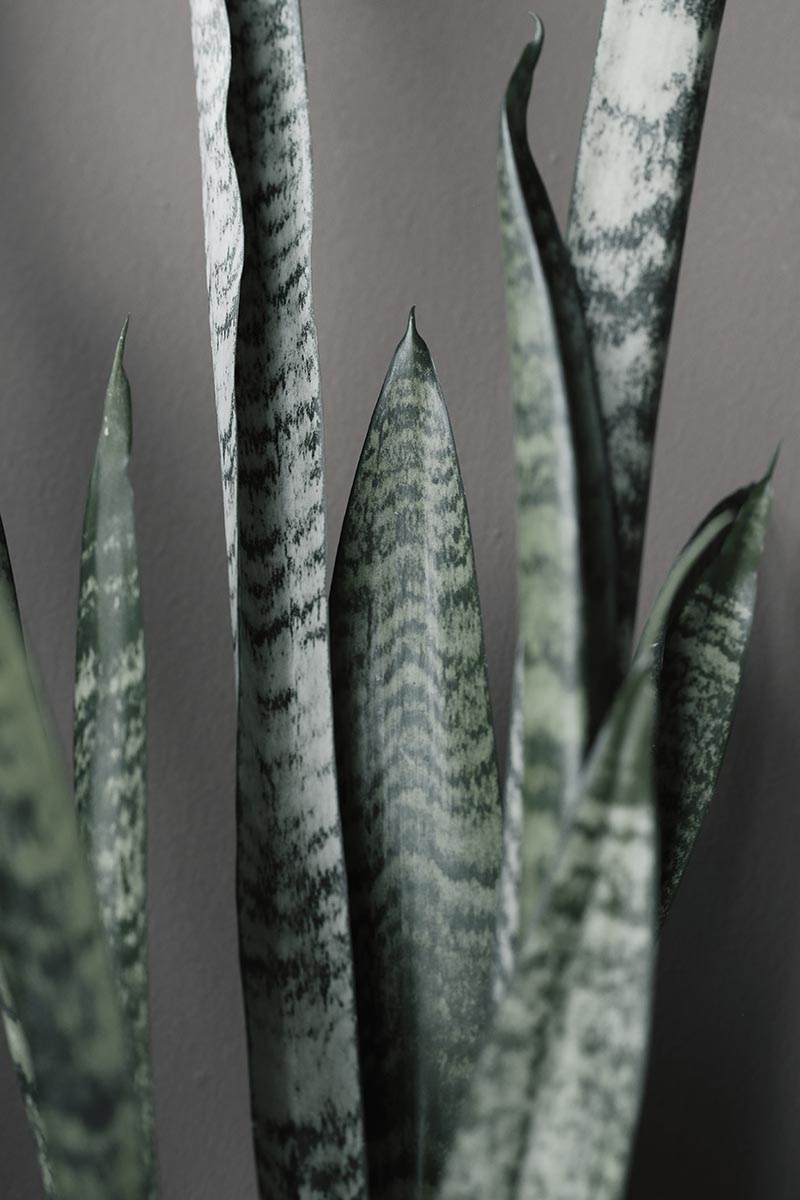
This cultivar tends to be a rather large specimen at maturity, reaching about three feet in height in most instances.
In low light conditions, the colors can deepen even further, hence the “black” part of the name. Note that in brighter light, the pattern is broken with more bright green.

Racemes of this cultivar are long and thin with dozens of spindly white to cream-colored flowers.
You can find ‘Black Coral’ in a six-inch grower’s pot, available from Hirt’s Garden Store via Amazon.
4. Black Gold
You’ll find a huge number of D. trifasciata hybrid cultivars on the market, but ‘Black Gold,’ sometimes called viper’s bowstring hemp, has a number of striking features that are uncommon among snake plants.
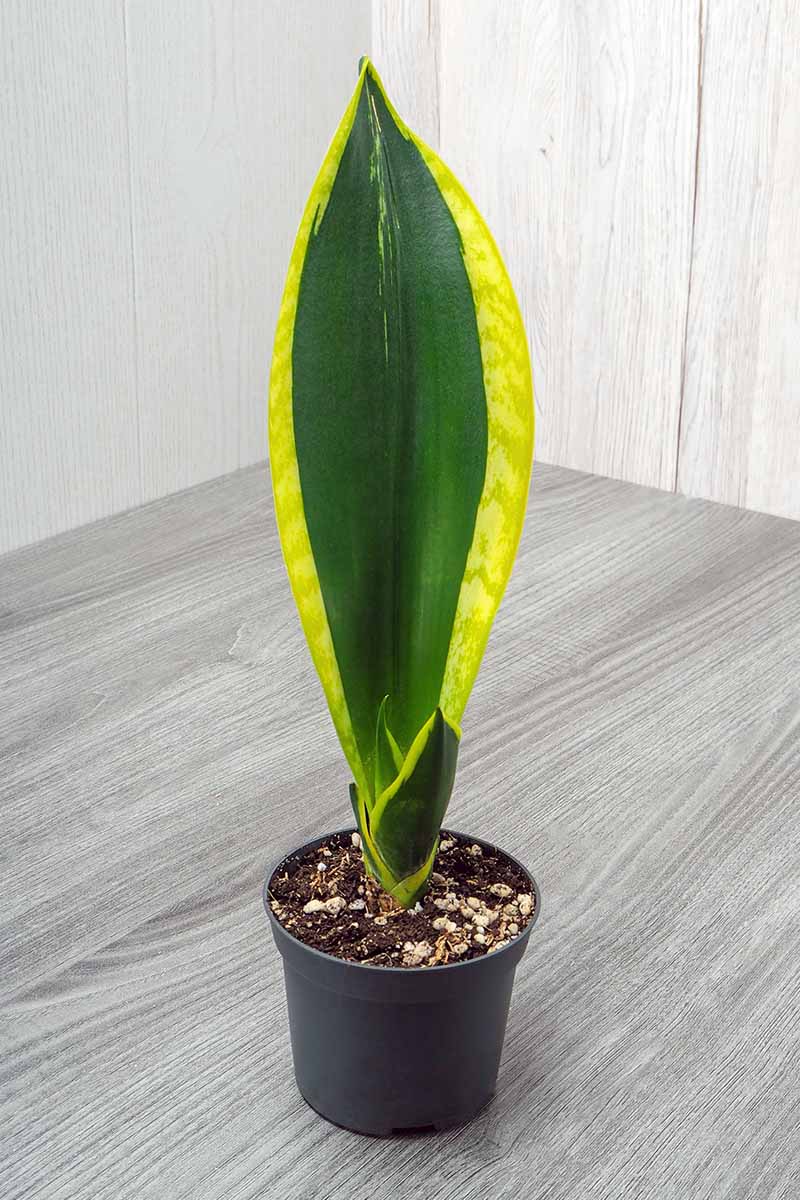
Most have banded foliage, but this cultivar tends to exhibit predominantly solid leaves instead. The deep green, almost black shade of the interior of the leaves really sets off the bright golden color that runs along the leaf margins.
It’s also a mid-sized type – rather than towering at over three feet in height like D. trifasciata, it remains more modestly sized at about 12 inches in height at maturity.
Younger ‘Black Gold’ specimens display shorter, flared leaves that become long, narrow, and sleek as they grow.
You can grab ‘Black Gold’ in a four-inch grower’s pot, available from Home Depot.
5. Black Star
For a big impact in a compact size, bring home D. hahnii (syn. S. hahnii) ‘Black Star,’ also known as ‘Yellow Bird’s Nest.’
This little beauty measures in at a modest 12 inches max, which means it can fit right into your apartment, on a shelf or in another small space.
What makes this dwarf cultivar a standout? The cream to yellow margins of the deep green foliage and the tight rosette of short, wide leaves, one nestled inside the other, radiating out from the center.
Another distinct characteristic of this variety is its lack of banding. Whereas many specimens on our list exhibit some type of pattern, the interior of ‘Black Star’ leaves is pure, solid green.
If it blooms, the creamy white flowers produced on the long raceme make a brilliant contrast with the foliage.
Bring one home in a two-inch grower’s pot from Hirt’s Gardens via Walmart.
6. Canaliculata
For a wilder, freeform look, D. canaliculata (syn. S. canaliculata) fits the bill.
The same firm, tubular leaves are displayed as in other cylindrical species, but unlike its more structured, fan-shaped cousins, this one has a habit that sometimes looks a bit willy-nilly.
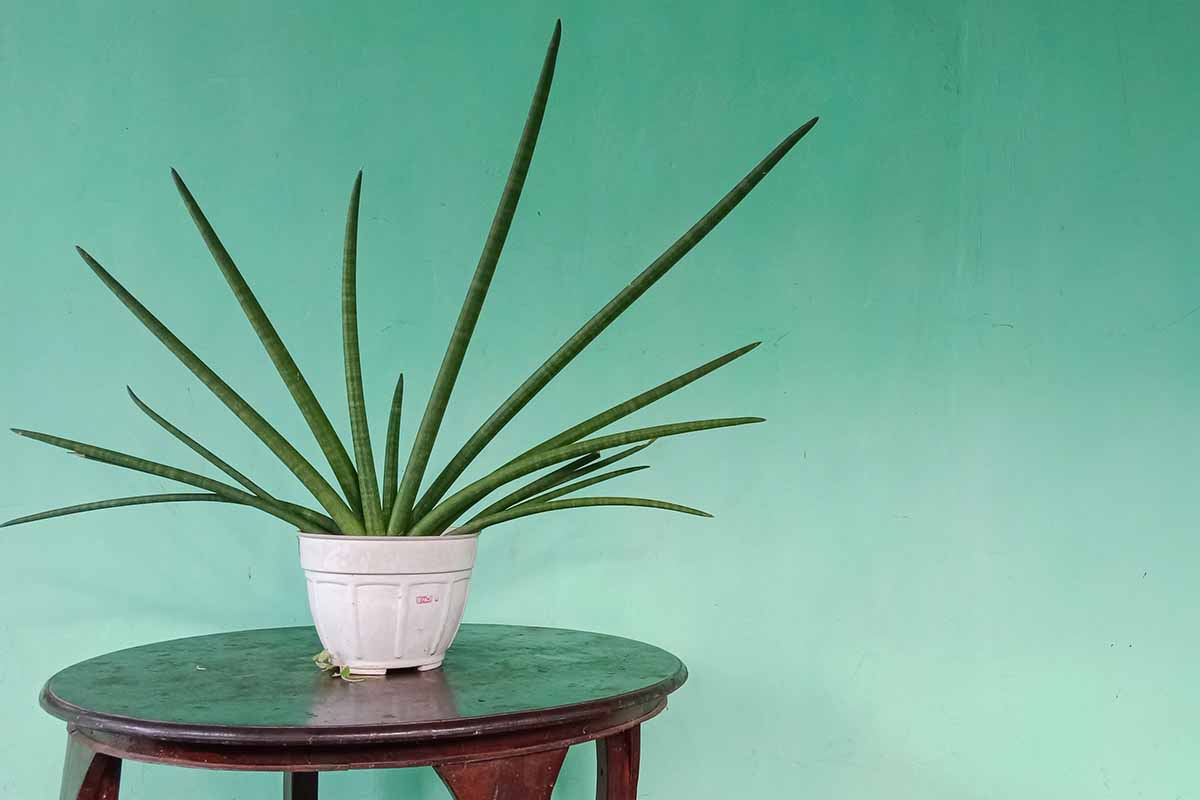
Leaves are slimmer, sometimes reaching three feet in height indoors, with bands of soft green and gray tones.
Some specimens may grow straighter and more upright, but some tend to produce foliage that leans at an angle from the stemless base for a truly curious appearance.
If a raceme develops, the buds will be soft lavender to pink, opening to feathery white flowers arranged closely on a long stem.
When this species spends the summer outdoors, it can reach heights of well over three feet.
7. Fernwood Mikado
If you prefer edgier houseplants that demand attention, look no further then D. bacularis (syn. S. bacularis) ‘Fernwood Mikado.’ This cultivar is surely the punk version of the average snake plant. It reminds me of Stripe, the leader of the Gremlins.
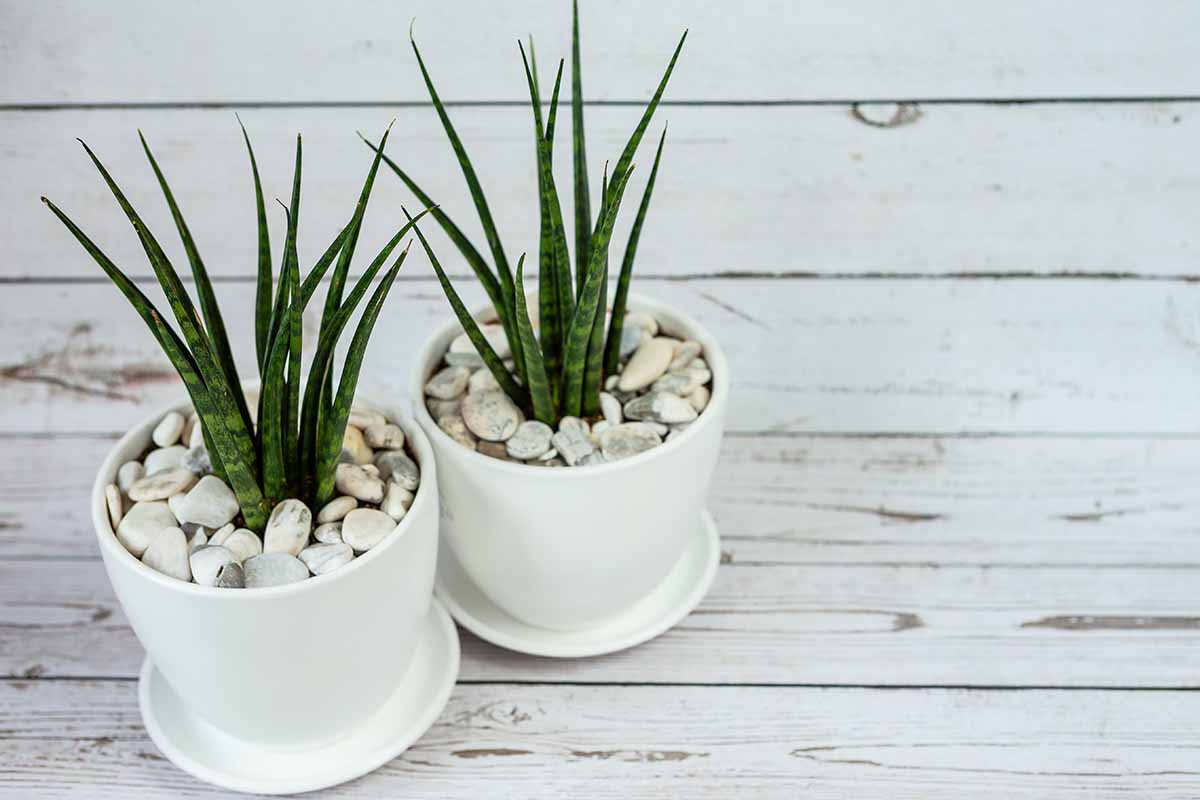
The slim, cylindrical leaves arranged in a spray from the single-stemmed base are like a green- and gray-striped mohawk in a pot.
In the right setting, though, this ‘Fernwood Mikado’ can be dressed up with a midcentury modern pot and stand or a glossy black vessel, and added to a classy home interior.

And, if the nuances of its form don’t catch your eye, you’ll certainly notice its size – which starts off small but can often reach two to four feet in height. It screams, “Pay attention!”
Add ‘Fernwood Mikado’ to your home with this young specimen in a two-inch grower’s pot, from Amazon.
8. Francisii
Perhaps one of the odd ducks on our list, D. francisii (syn. S. francisii) has a unique growth habit that is rarely found among snake plants. If you’re looking for a conversation piece, this may be your best choice.
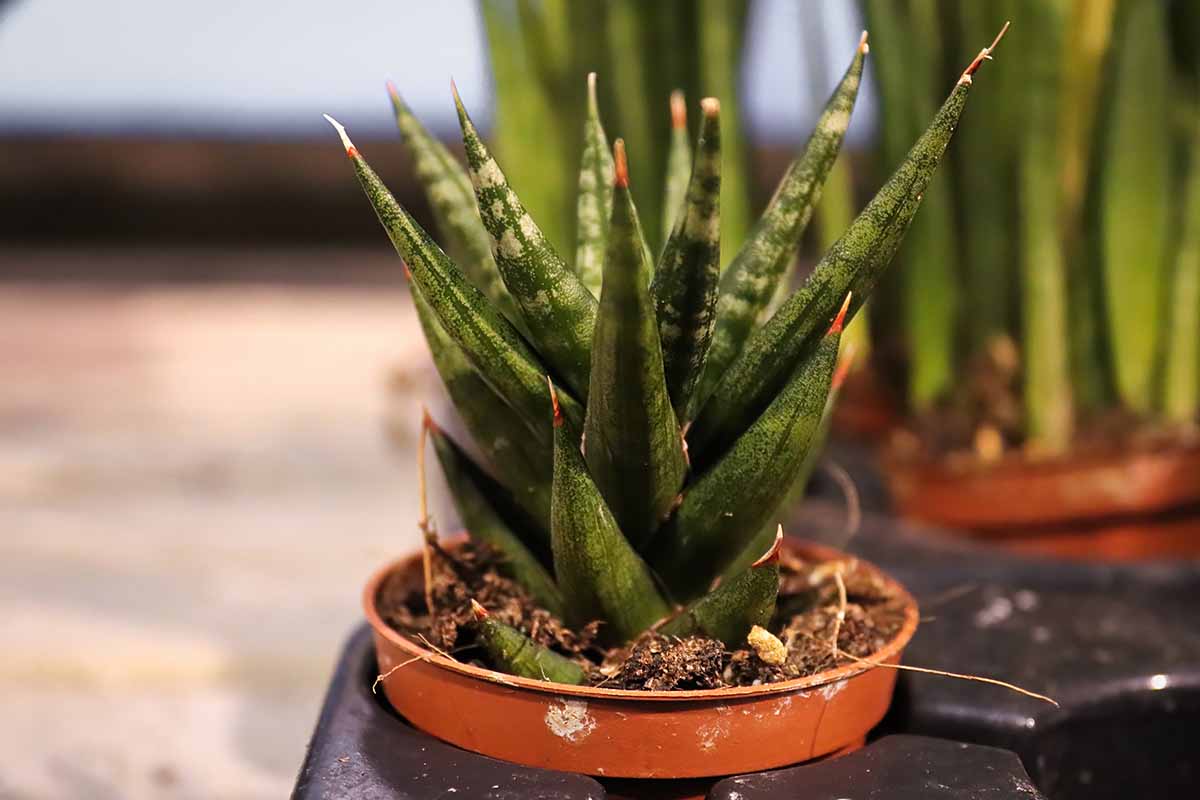
Unlike others that produce leaves from a central stem at soil level, or that produce individual leaves, this species produces a tough central stem from which the thick, succulent green leaves with gray banding sprout.
Leaves are tightly arranged on the stems, which are stoloniferous – that is, when a new stem sprouts from the base of the existing stem, it creeps horizontally until it generates roots to produce a new plant.
Strawberries are another example of a stoloniferous plant.
Though each stem reaches a height of no more than about two feet at maturity, the spread can become rather wide as new stems sprout and grow.
New stolons that grow from the base of the stem can be pruned and repotted after they have set leaves, if size becomes a concern.
Young plants tend to resemble other stemless varieties until they mature.
9. Gold Hahnii
What’s that, you say? You like color? Well, I have an option that might be exactly right for you.
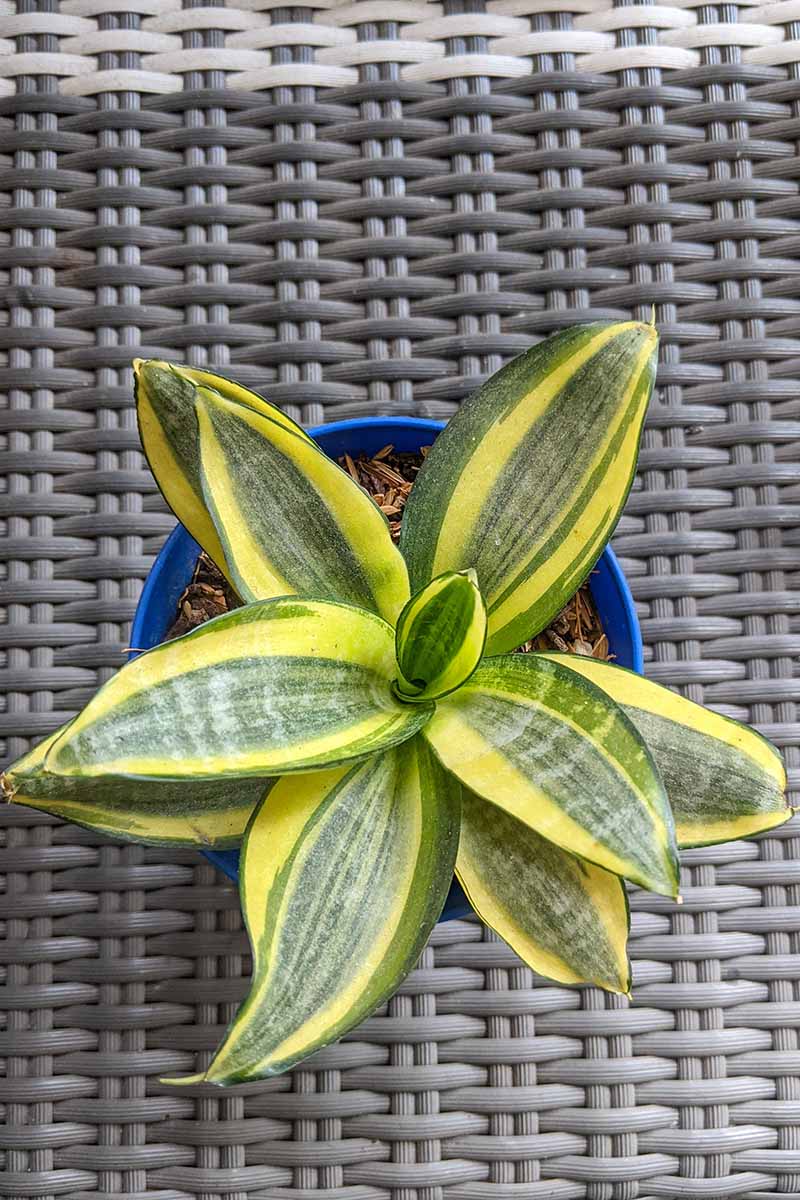
D. trifasciata ‘Gold Hahnii’ (syn. S. trifasciata ‘Gold Hahnii’) is a dwarf cultivar that reaches a modest eight to 10 inches at maturity, sporting distinctive yellow-green leaves with green to golden margins.
Also known as the golden bird’s nest snake plant, a small specimen like this can easily make a big impact when planted in multiples in separate pots or grouped together in one large planter.
Color can vary slightly, with some exhibiting more gray-green banding on the interior of the leaves than others. It’s unlikely to see blooms from this dwarf cultivar, but if they do develop, they’ll be bright white against a long, green stem.
Introduce one – or more! – ‘Gold Hahnii’ into your home with these specimens in four-inch grower’s pots, available from Home Depot.
10. Jaboa
While it has a similar pattern of darker and lighter green mottling like our previous entry, D. trifasciata ‘Jaboa’ achieves new heights!
Reaching a big, beautiful, 24 to 36 inches at full height, it’s one that will become the focus of any room.
Pair it up with larger houseplants like bird of paradise or areca palm for your own private indoor jungle, use it as the focal point in a group of smaller species – or let it stand alone.
When this cultivar blooms, it’s just as distinctive as the rest of the plant! A long stem forms with a tuft of wispy buds at the upper end, in tones of white and yellow. The flowers then open to white and cream with curled petals and large stamens. Amazing!
You can find a 10-inch ‘Jaboa’ available from 305 Plants Online via Walmart.
11. Laurentii
Perhaps someone you knew as a kid had a snake plant that you loved, and you want to find one that looks just like it for your own home.
There’s a good chance that D. trifasciata (syn. S. trifasciata var. laurentii) ‘Laurentii’ may be the variety you’re looking for since it’s been the most common type in cultivation for decades.
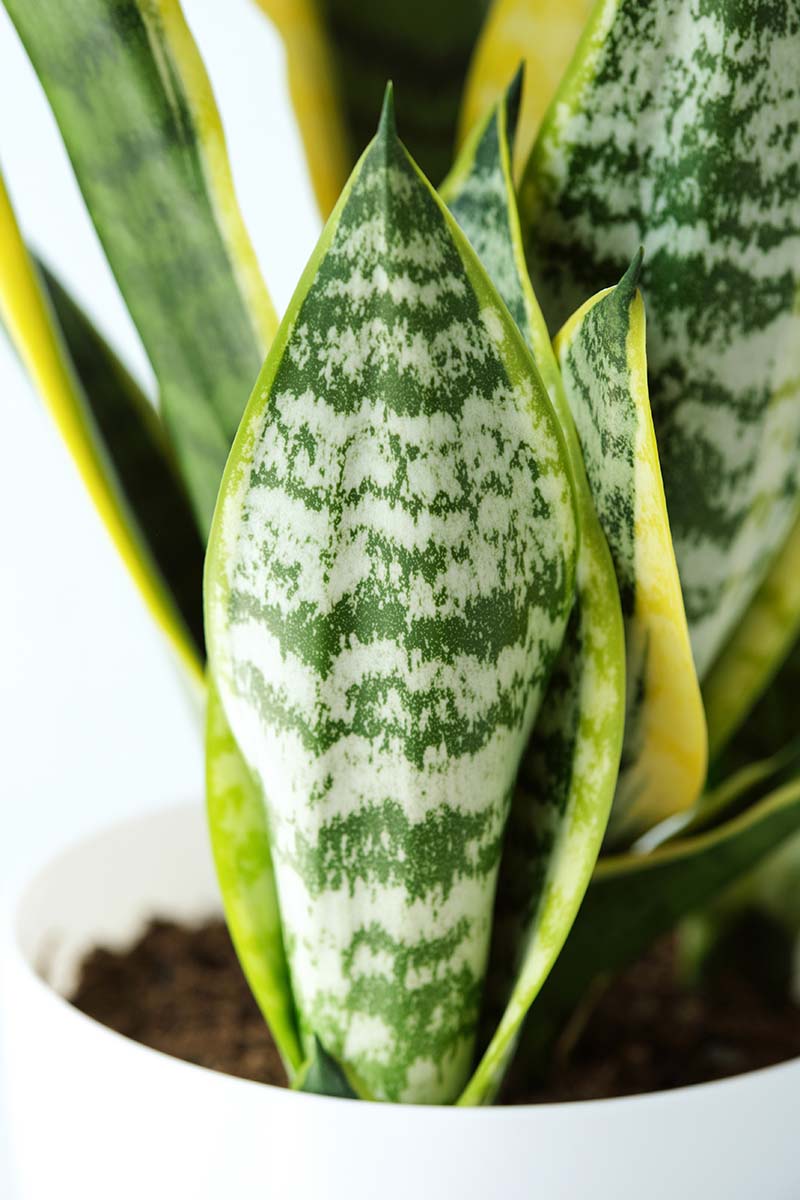
As one of the most recognizable types, ‘Laurentii’ reaches heights of three feet or more as a houseplant.
The distinct gray-green bands and creamy yellow margins stand out on long, slim, tapered leaves.
Like most other species, blooms develop on a long stem and both buds and blossoms are white.
Why not take the plunge and bring a lovely ‘Laurentii’ home from Terrain?
12. Moonshine
Now, we come to my personal favorite on this list – D. trifasciata (syn. S. trifasciata) ‘Moonshine.’ This stunning, yet subtle specimen is the epitome of tranquility with soft, watercolor-like pale green leaves touched with a hint of silver-gray.
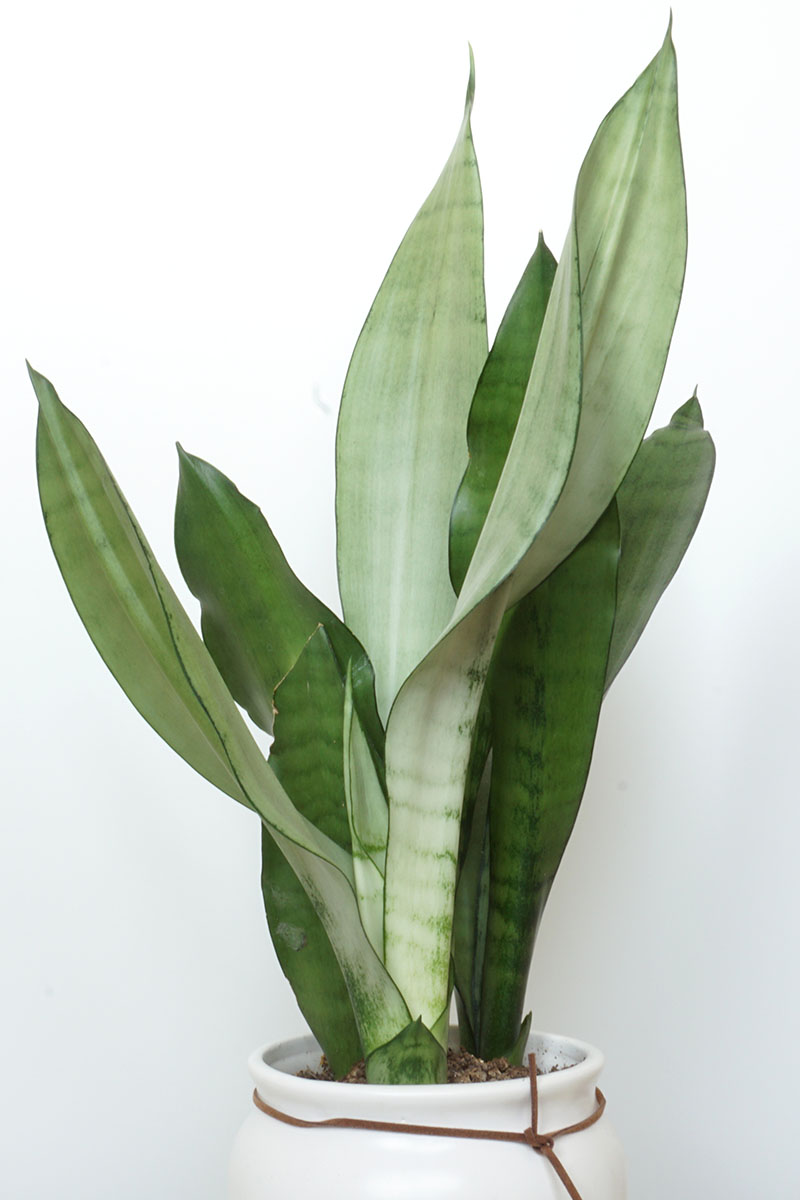
Not only is the color amazing, but the structure is too. Leaves widen in the middle with narrow, pointed tips, and a slight flare that lends this cultivar a seemingly undulating, kelp-like shape.
Clustered together with their tall rosettes and reaching up to two feet at maturity, these plants become a simple, unassuming focal point.
Blossoms that may occasionally appear on ‘Moonshine’ are clustered along a thin, tall raceme, beginning as yellow-tinged white buds and opening to white, delicate flowers.

If you’ve fallen in love with this cultivar as I have, you can snag one via California Tropicals in a four-inch grower’s pot, via Amazon.
13. Skyline
The ‘Skyline’ cultivar, sometimes referred to as skyline spear, has two- to four-foot-long leaves that form stiff tubes in a lovely fan shape. Green and gray bands cover the length of each leaf to the tips, with a pointed finish.
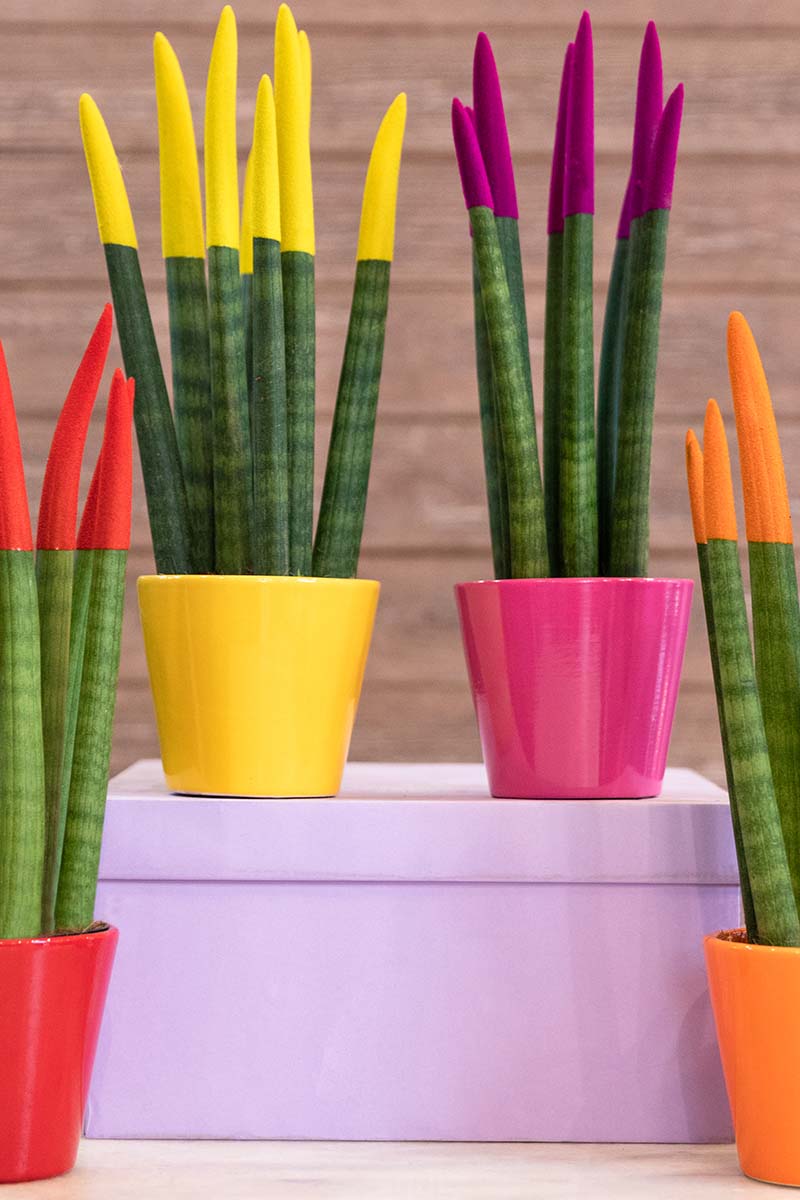
The cylindrical-leaved D. angolensis (syn. S. cylindrica) is sometimes sold as ‘Velvet Touch,’ but don’t be fooled – this is not a cultivar.
It’s simply a plant whose leaves have unfortunately been dipped in paint. New leaves will grow in green to match the rest of the foliage.
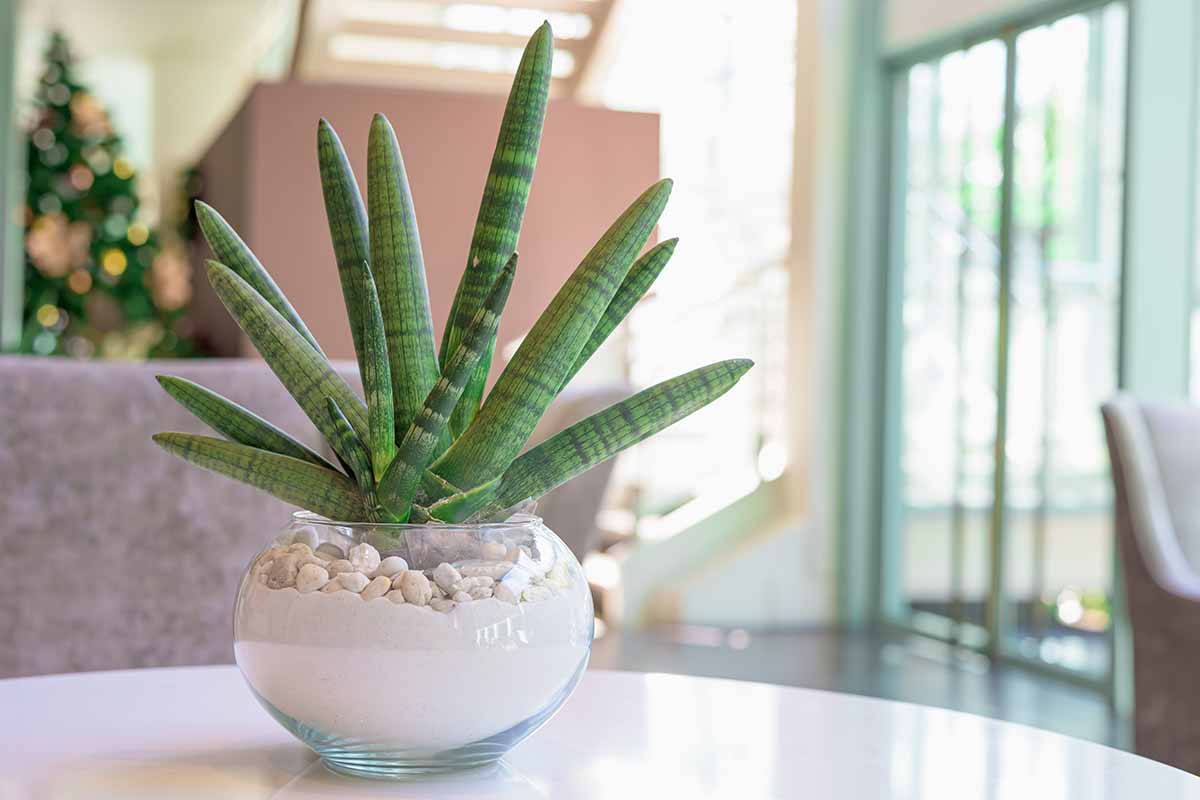
Leaves are also commonly braided together with a band at the tips to hold them in place, and tagged as ‘Braid’ – although, this is not a cultivar either.
Rarely, a raceme may form, loaded with pale lavender to pink buds that open to delicate white blooms. Offshoots may also develop, which typically grow at an angle to the original plant, forming an interesting spray of green spears.

A potted, braided specimen of this species is available at Amazon.
14. Star
Known commonly as star Sansevieria, D. pethera (syn. S. kirkii) is a little more challenging to track down, but well worth the search.
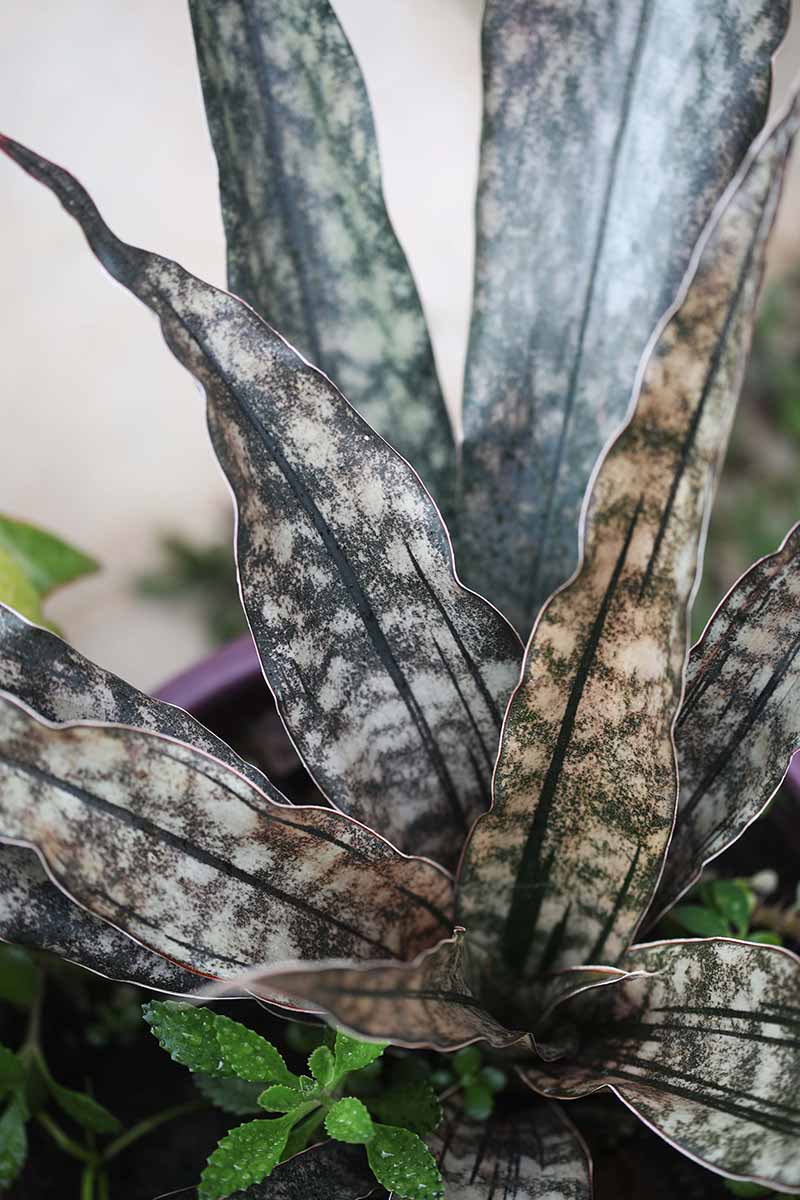
This species begins as a small, perhaps lackluster, and nearly flat, low-lying plant with just a few leaves.
Over time, new foliage grows in upright form with a mottled, gray-green color pattern and undulating leaf margins that have inspired the development of new cultivars such as ‘Coppertone.’
Size can vary with container-grown plants – they sometimes top out at no more than two feet in height but can easily reach up to four feet at maturity in ideal conditions indoors.
For a larger specimen, move plants outdoors in temperatures over about 60ﹾF where they may reach six feet in height and spread. This practice may also induce blooming.
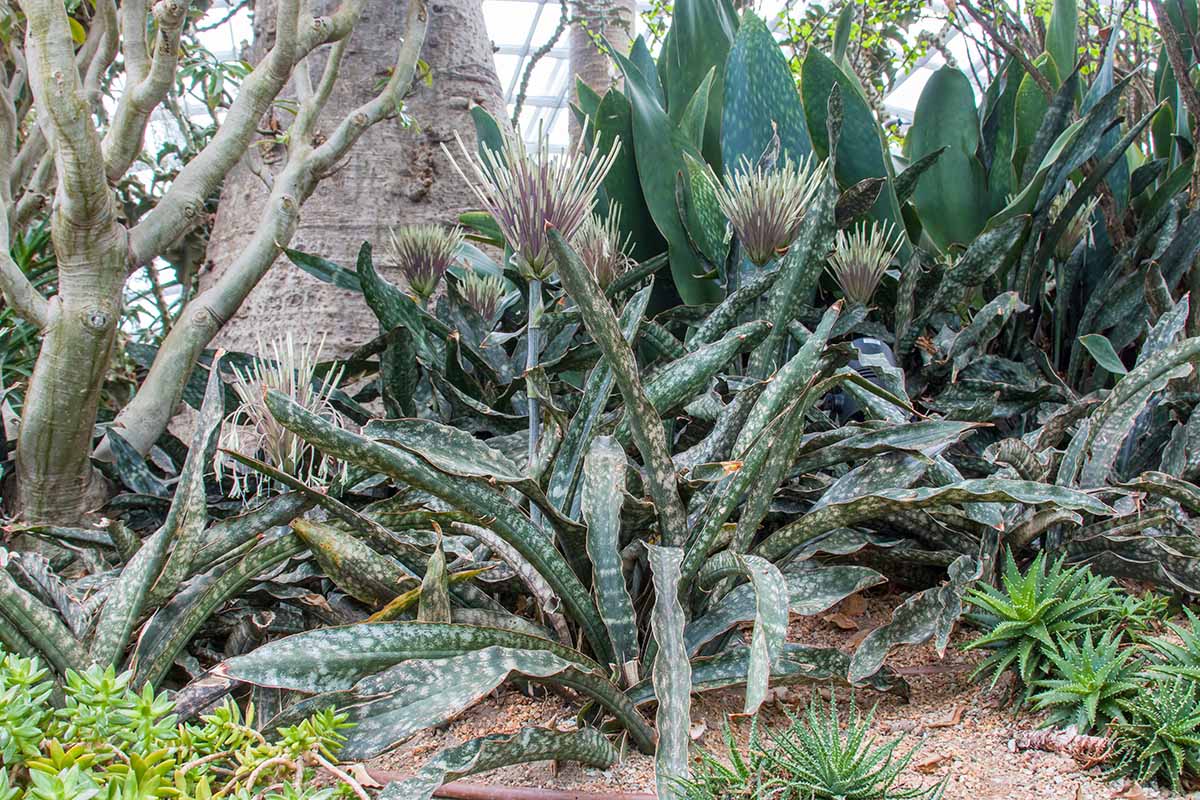
Blooms are also very unique in this species. Rather than a long raceme packed with flowers, it sprouts a long stem with a tuft of buds and blooms at the tip that have a faint pink to lavender tone.
15. Starfish
Another cultivar of D. angolensis var. patula, ‘Boncel’ or ‘Starfish’ was bred for petite size and thick, stout cylindrical leaves. This cultivar is sometimes referred to as “spear orchid,” even though it’s not an orchid.
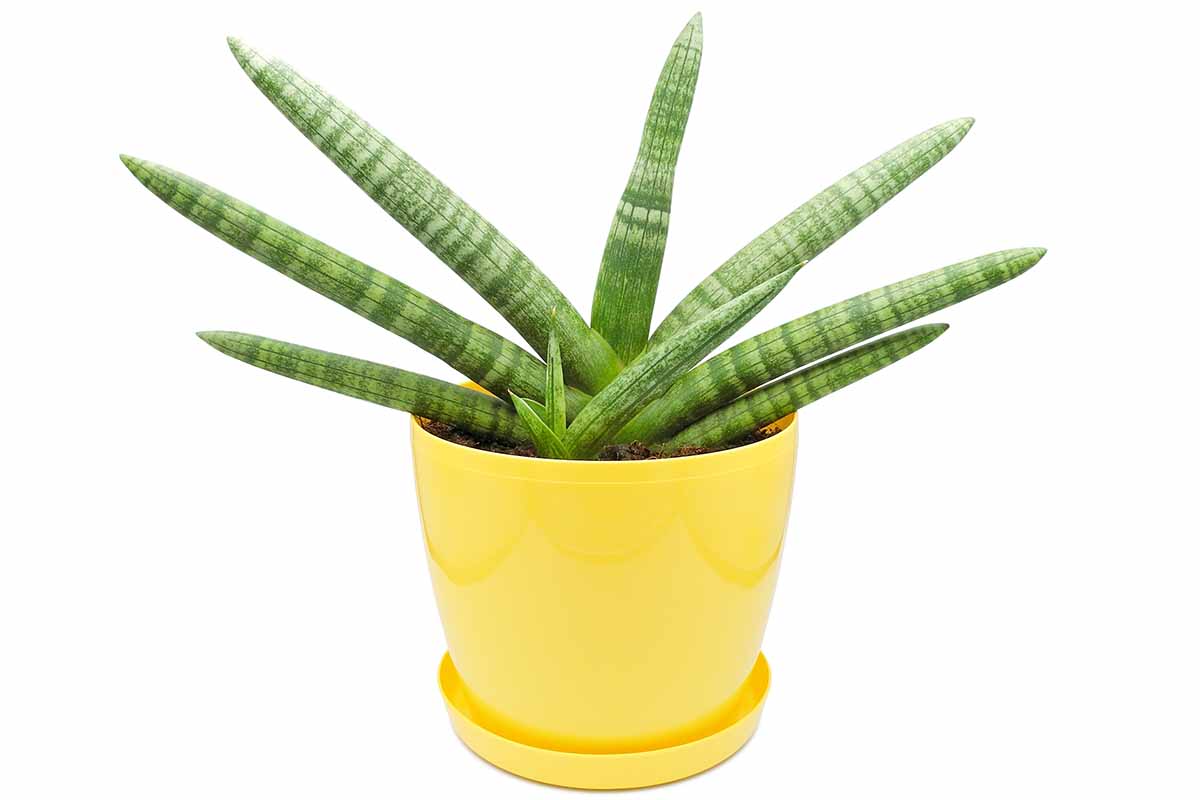
As a dwarf, this specimen typically reaches no more than about 10 to 12 inches in height, with rare specimens reaching 18 to 20 inches tall under ideal conditions. It has the familiar fan shape and green-gray banded leaves of most D. angolensis plants.
In suitable conditions, offshoots can develop that fill a pot from wall to wall. As with other varieties, they can easily be divided and repotted individually for a house full, or given as gifts to friends and family.
Blooming is exceptionally rare for this cultivar, but if full sunlight is provided, blossoms may form on a long raceme that can sometimes stretch to twice the height of the leaves.
Buds are pink to white, opening to reveal white flowers with a tuft-like arrangement.
16. Starlight
Dwarf D. hahnii ‘Starlight’ (syn. S. hahnii) is a short and stout version of its big brothers. The light green leaves with darker green and gray banding are tipped along the margins with cream or pale yellow and arranged in a tight rosette.
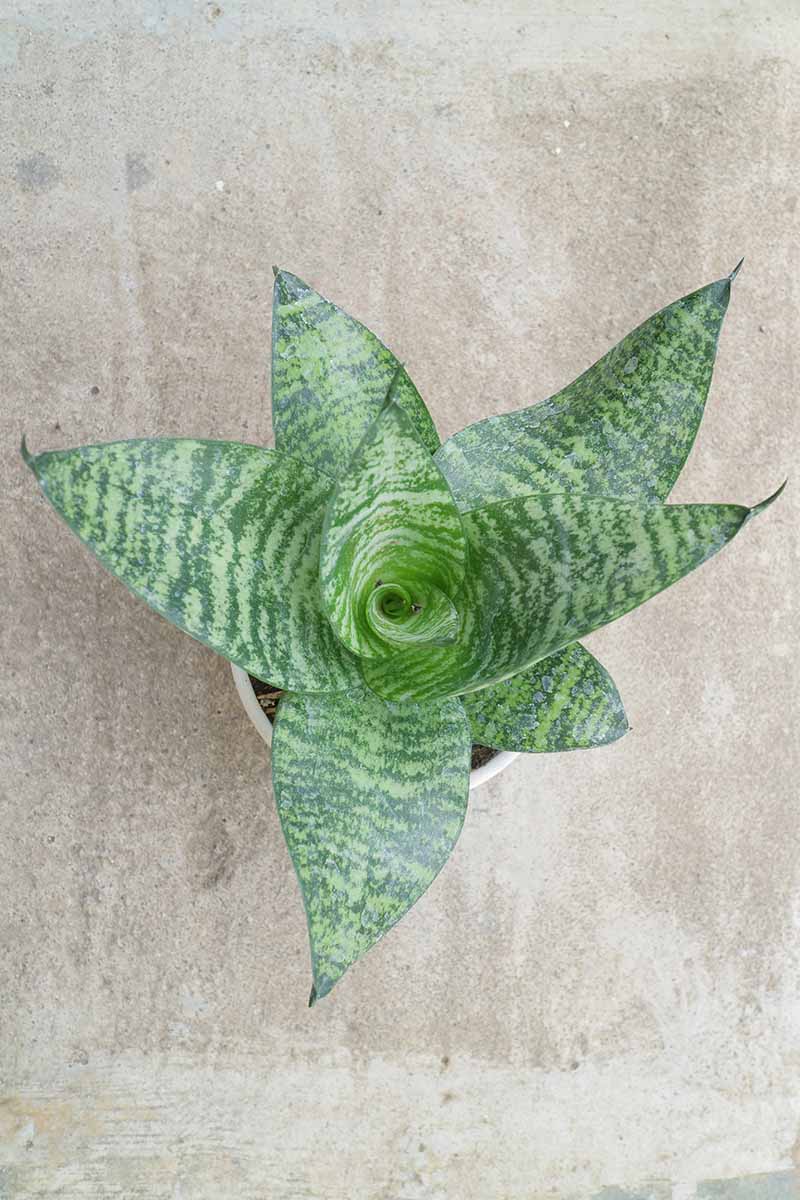
If you have a small space for indoor containers, this one won’t cramp your style. It tops out at about eight to 10 inches in height with an equally small spread. Instead of the long, sleek leaves exhibited by many varieties, this one has short, wide, waxy leaves.
In the unlikely event that this cultivar blooms, the flowers appear on a long stem in close rows. Both buds and blooms are white and feathery.
Grab one in a four-inch pot, available from House Plant Shop via Walmart.
17. Superba
For simple, classic style with a touch of flair, D. laurentii (syn. S. laurentii) ‘Superba,’ aka ‘Superba Robusta,’ is a perfect choice.
This midsized cultivar achieves about 12 to 14 inches in mature height and exhibits green and gray banded leaves with bright, golden yellow along the margins.

It’s one of the easiest to find among growers and nurseries because this plant is one of the hardest to kill, while adding more than just simple greenery to the home interior nonetheless.
When it does bloom, the raceme it produces is loaded with white to off-white flowers.
Pick up a ‘Superba’ in a grower’s pot from Burpee.
18. Twisted Sister
Snake plant with a twist! For a cultivar that has traits that differ from all the other siblings, dwarf D. trifasciata (syn. S. trifasciata) ‘Twisted Sister,’ also called ‘Twist,’ is it.
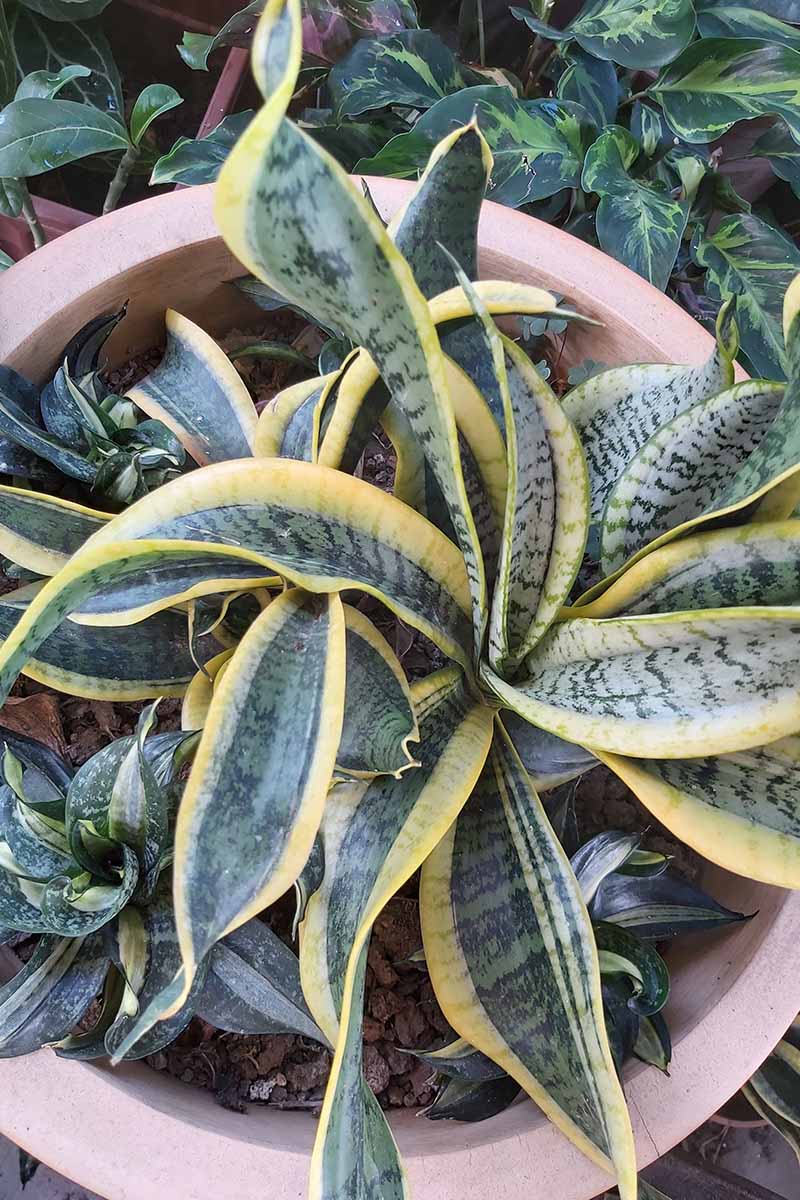
This dwarf cultivar grows no more than about 15 inches in height at maturity, and exhibits a color pattern similar to its parents, D. laurentii and ‘Gold Hahnii,’ with golden leaf margins and gray-green banding – but the difference here is that ‘Twisted Sister’ is, well… twisted.
Leaves grow in a distinctive curved, corkscrew form that adds texture and shadow play to this specimen, making it a stunning addition to any indoor garden. In some instances, the foliage can create a rounded, bird’s nest or pinwheel-like shape.
If growth becomes unwieldy, it’s easy to divide offshoots to transplant for a less chaotic appearance that isn’t overcrowded.
‘Twisted Sister’ is available in a four-inch grower’s pot from High Five Plants via Walmart.
19. Whale Fin
Uncommon plant collectors will appreciate D. masoniana (syn. S. masoniana) ‘Whale Fin,’ also known as ‘Whale’s Fin,’ ‘Shark Fin,’ or ‘Mason’s Congo.’

This cultivar is sometimes grown as a single leaf like sweetheart hoya, which perhaps sounds a bit dull. But once you see it, you’ll understand why. Leaves reach about three feet in height indoors, with a dark and light green mottled pattern.
‘Whale Fin’ has leathery leaves that are elliptical, resembling a whale’s fin breaching the ocean surface.
Each rhizome produces only one or two leaves, but as these rhizomes spread, new offshoots form nearby. In a large, wide planter placed outdoors in USDA Hardiness Zones 10 and 11, size and spread may become much larger.
Unlikely buds and blooms are greenish white.
Find a young specimen available from Hirt’s Gardens via Walmart in a four-inch grower’s pot.
20. Whitney
If you enjoy the darker tones present in some of these cultivars, then D. trifasciata (syn. S. trifasciata) ‘Whitney’ could be your girl.
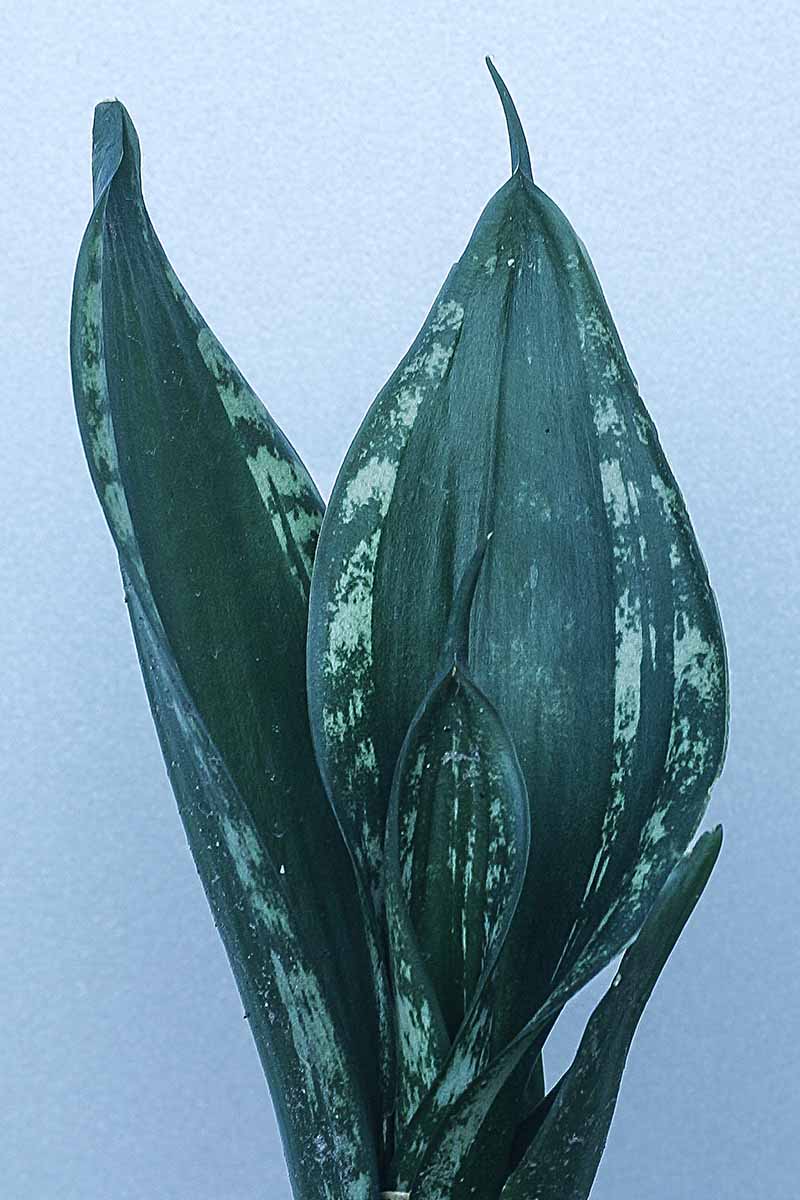
Like some of its cousins, ‘Whitney’ exhibits tipping and banding along its margins. It differs with its deep green leaf interiors and white and green banded leaf margins appearing on 18- to 20-inch-tall foliage with a four- to six-inch width.
As it forms rosettes, the wide foliage fills out the available space and sends out offshoots. Lower light and age result in deeper tones.
If blooms appear, they’re scattered along a tall raceme and display a soft white hue.
If ‘Whitney’ is the one for you, bring her home in a 10-inch grower’s pot from 305 Plants Online via Walmart.
21. Zeylanica
Like most of the larger species on our list, D. zeylanica (syn. S. zerlanica) can reach heights of three feet at maturity, or sometimes more. If you’re searching for a statement piece, this is a good option.

The soft and dark green, or sometimes slightly blue-toned, mottled banding of this species is what sets it apart from the others.
With that eye-catching, zebra-like pattern on long, slightly flared leaves, you’re sure to notice it. Leaves sometimes have a darker margin that also accentuates their flowing shape.
Racemes are long and bright green, with yellow to white buds and white blooms that have a spidery shape.
Ready to bring one home? Take a look at this eight- to 14-inch specimen, available in a grower’s pot from Terrain.
They also have the same species and size available in a swanky brass pot so there’s no transplanting necessary.
Snakes That You Won’t Hesitate to Keep Inside Your Home!
Variety is the spice of life, as they say.
But with so much variety, it may be hard to decide which to choose. Hopefully we’ve made the selection process a little easier. The good news is that there are options available that will blend in or stand out no matter what your interior decorating style may be.
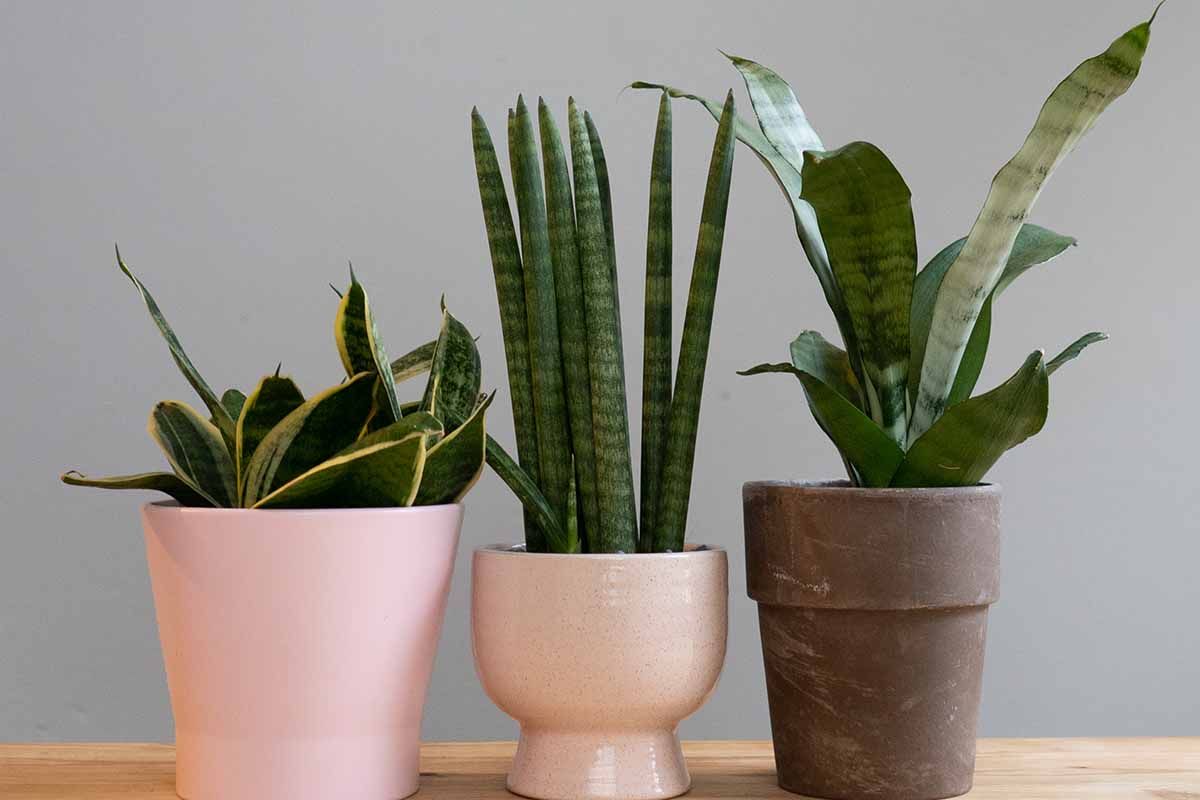
Hopefully you’ve found some interesting candidates that will fit perfectly into your collection – let us know in the comments section below. There may be a few on this list that I have bookmarked for myself…
If you’re on a houseplant hunting mission, we’ve got tons of articles that you might want to read – here are a few suggestions to look at next:
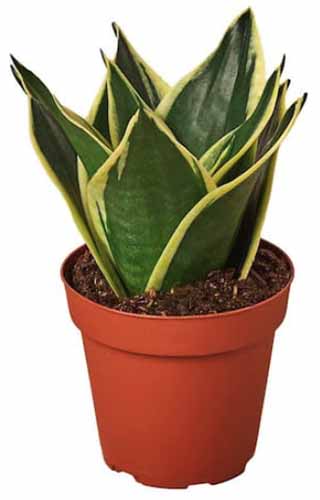

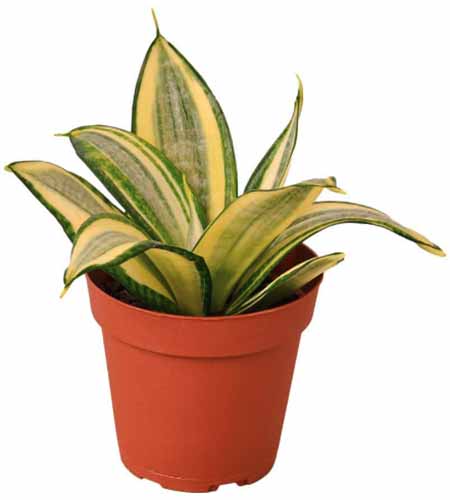

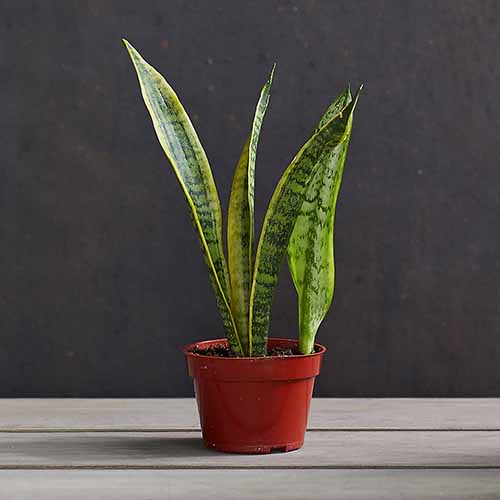

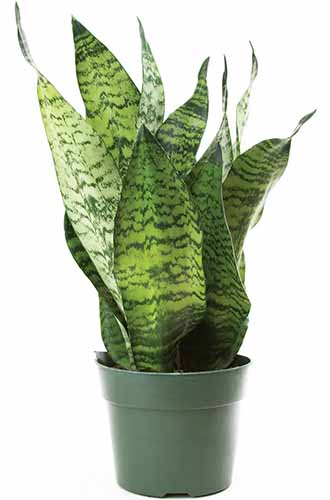







Loved the variety of plants, while learning about some new species as well. Now I’m ready to go plant hunting. thanks for sharing!
Thanks for reading Susan! Let us know which snake plant you end up with.
Thanks for sharing!!! I have a few snake plants, including moonshine !!!
It’s my favorite also.
Now I need to add a few more to my collection!!!
Hi Susan, you can never have too many snake plants! Thanks for reading.